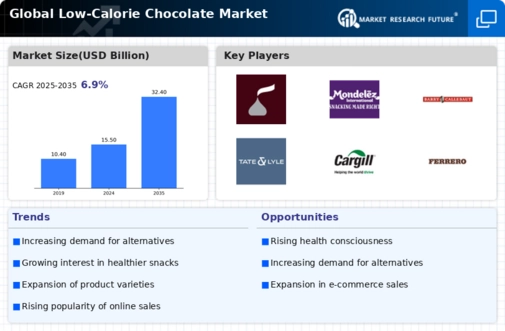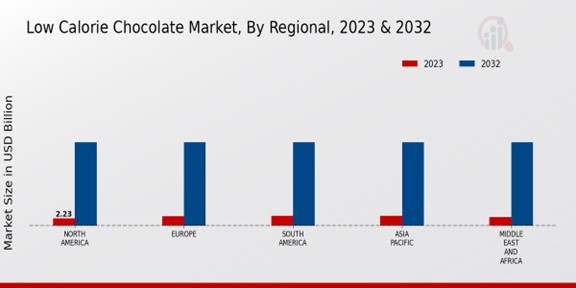E-commerce Expansion
The expansion of e-commerce platforms significantly influences the Global Low-Calorie Chocolate Market Industry, providing consumers with convenient access to a wide range of products. Online shopping has become increasingly popular, allowing consumers to explore various low-calorie chocolate options from the comfort of their homes. This trend is expected to bolster market growth, as e-commerce sales contribute to the overall market value. The ease of purchasing low-calorie chocolates online not only enhances consumer convenience but also enables brands to reach a global audience, thereby expanding their market presence. As e-commerce continues to grow, it is likely to play a pivotal role in shaping the future of the industry.
Health Consciousness
The increasing awareness of health and wellness among consumers drives the Global Low-Calorie Chocolate Market Industry. As individuals become more health-conscious, they seek alternatives to traditional chocolate that offer lower calorie counts without sacrificing taste. This trend is reflected in the projected market value of 15.5 USD Billion in 2024, indicating a robust demand for healthier options. The rise in obesity rates and related health issues has further propelled consumers towards low-calorie products, suggesting a shift in dietary preferences. Consequently, manufacturers are innovating to create low-calorie chocolates that cater to this growing demographic.
Market Growth Projections
The Global Low-Calorie Chocolate Market Industry is poised for substantial growth, with projections indicating a market value of 15.5 USD Billion in 2024 and an anticipated increase to 32.4 USD Billion by 2035. This growth trajectory suggests a robust demand for low-calorie chocolate products, driven by various factors such as health consciousness and innovative product development. The expected compound annual growth rate (CAGR) of 6.91% from 2025 to 2035 further underscores the industry's potential for expansion. As consumer preferences continue to evolve, the market is likely to witness an influx of new entrants and product offerings, contributing to a dynamic and competitive landscape.
Changing Consumer Preferences
The Global Low-Calorie Chocolate Market Industry is shaped by evolving consumer preferences, particularly among younger demographics who prioritize healthier snacking options. As millennials and Generation Z become more influential in the market, their inclination towards guilt-free indulgence drives demand for low-calorie chocolates. This shift in preferences is indicative of a broader trend towards mindful eating, where consumers seek products that align with their health goals. The industry's ability to adapt to these changing preferences is crucial for sustained growth, as brands that resonate with the values of these consumers are likely to thrive in the competitive landscape.
Innovative Product Development
Innovation plays a crucial role in the Global Low-Calorie Chocolate Market Industry, as manufacturers continuously develop new flavors and formulations to attract consumers. The introduction of unique ingredients and textures enhances the appeal of low-calorie chocolates, making them more enticing to a broader audience. This focus on innovation is likely to contribute to a compound annual growth rate (CAGR) of 6.91% from 2025 to 2035. Brands are experimenting with exotic flavors and functional ingredients, such as added protein or fiber, to differentiate their products in a competitive market. This ongoing development is essential for maintaining consumer interest and driving market growth.
Rising Demand for Sugar Alternatives
The Global Low-Calorie Chocolate Market Industry is experiencing a surge in demand for sugar alternatives, driven by consumers' desire to reduce sugar intake. With the increasing prevalence of diabetes and other sugar-related health concerns, many individuals are actively seeking products that utilize natural sweeteners or sugar substitutes. This shift is evident in the market's anticipated growth, projected to reach 32.4 USD Billion by 2035. Companies are responding by formulating low-calorie chocolates that incorporate ingredients like stevia and erythritol, appealing to health-conscious consumers. This trend not only enhances product offerings but also aligns with broader dietary shifts towards lower sugar consumption.











